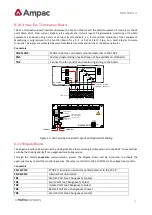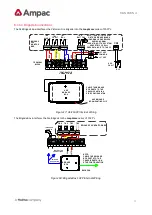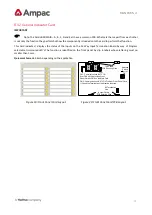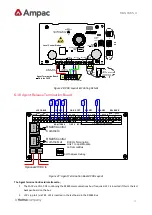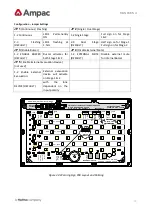
MAN1565-4
26
Silences the buzzer if activated by an alarm or fault condition that has been recognised and
announced at the FACP. The LAM buzzer can also be silenced by the FACP silence buzzer function.
Indicators
There are twenty four active indicators on the front panel of the LAM.
Flashing indicators are used, the on / off periods are not less than 0.25 seconds and the flash frequencies are not less
than:
1Hz for alarm indications (0.5 second on, 0.5 second off)
0.5Hz for fault indications (1 second on and 1 second off)
(RED)
The common Alarm indicator will be flashing when an alarm condition is present. The
indicator will become steady when the acknowledge control is pressed at the FACP
Any new alarm condition recognised at the FACP will cause the indicator to resume flashing.
(YELLOW)
The fault indicator is illuminated steady by the presence of any fault. Refer to the
FACP manual for details on fault conditions.
(AMBER)
The isolated indicator is illuminated steady by the presence of any isolate condition
on any zone, device or output.
(AMBER)
Illuminated flashing at the fault rate by an open or short circuit condition on the
FACP bell output.
Indicator will extinguish when the open or short condition has cleared.
(AMBER)
Illuminated flashing at the fault rate by an open or short circuit condition on the
FACP warning system output.
Indicator will extinguish when the open or short circuit has cleared
(AMBER)
Illuminated flashing at the fault rate by an open or short circuit condition on the
FACP ACF output.
Indicator will extinguish when the open or short condition has cleared
When the ACF output is isolated, then the indicator will be illuminated steady.
Display priority: Isolate (steady) then fault (flash)
(AMBER)
Illuminated flashing at the fault rate by an open or short circuit condition on the
FACP ASE output.
Indicator will extinguish when the open or short condition has cleared.
(GREEN)
The indicator is illuminated steady when the FACP is supplied with power (mains or
battery) and flashes at the fault rate when there is a fault with the power supply equipment. A fault can be no mains,
high charger voltage, no charger voltage, low battery voltage or missing (or damaged) battery.










